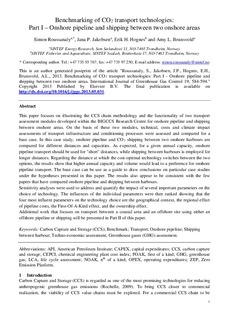| dc.contributor.author | Roussanaly, Simon | |
| dc.contributor.author | Jakobsen, Jana Poplsteinova | |
| dc.contributor.author | Hognes, Erik Skontorp | |
| dc.contributor.author | Brunsvold, Amy | |
| dc.date.accessioned | 2017-07-06T13:08:56Z | |
| dc.date.available | 2017-07-06T13:08:56Z | |
| dc.date.created | 2013-08-05T15:35:51Z | |
| dc.date.issued | 2013 | |
| dc.identifier.citation | International Journal of Greenhouse Gas Control. 2013, 19 584-594. | nb_NO |
| dc.identifier.issn | 1750-5836 | |
| dc.identifier.uri | http://hdl.handle.net/11250/2448096 | |
| dc.description.abstract | This paper focuses on illustrating the CCS chain methodology and the functionality of two transport assessment modules developed within the BIGCCS Research Centre for onshore pipeline and shipping between onshore areas. On the basis of these two modules, technical, costs and climate impact assessments of transport infrastructure and conditioning processes were assessed and compared for a base case. In this case study, onshore pipeline and CO2 shipping between two onshore harbours are compared for different distances and capacities. As expected, for a given annual capacity, onshore pipeline transport should be used for “short” distances, while shipping between harbours is employed for longer distances. Regarding the distance at which the cost-optimal technology switches between the two options, the results show that higher annual capacity and volume would lead to a preference for onshore pipeline transport. The base case can be used as a guide to draw conclusions on particular case studies under the hypotheses presented in this paper. The results also appear to be consistent with the few papers that have compared onshore pipeline and shipping between harbours. Sensitivity analyses were used to address and quantify the impact of several important parameters on the choice of technology. The influences of the individual parameters were then ranked showing that the four most influent parameters on the technology choice are the geographical context, the regional effect of pipeline costs, the First-Of-A-Kind effect, and the ownership effect. Additional work that focuses on transport between a coastal area and an offshore site using either an offshore pipeline or shipping will be presented in Part II of this paper. © 2013 Elsevier Ltd. All rights reserved. | nb_NO |
| dc.language.iso | eng | nb_NO |
| dc.rights | Navngivelse 4.0 Internasjonal | * |
| dc.rights.uri | http://creativecommons.org/licenses/by/4.0/deed.no | * |
| dc.title | Benchmarking of CO2 transport technologies: Part I—Onshore pipeline and shipping between two onshore areas | nb_NO |
| dc.type | Journal article | nb_NO |
| dc.type | Peer reviewed | nb_NO |
| dc.description.version | acceptedVersion | nb_NO |
| dc.rights.holder | Authors have copyright to postprint version | nb_NO |
| dc.source.pagenumber | 584-594 | nb_NO |
| dc.source.volume | 19 | nb_NO |
| dc.source.journal | International Journal of Greenhouse Gas Control | nb_NO |
| dc.identifier.doi | 10.1016/j.ijggc.2013.05.031 | |
| dc.identifier.cristin | 1041662 | |
| dc.relation.project | Norges forskningsråd: 193816 | nb_NO |
| cristin.unitcode | 7548,60,0,0 | |
| cristin.unitcode | 7569,83,0,0 | |
| cristin.unitname | Gassteknologi | |
| cristin.unitname | Fiskeriteknologi | |
| cristin.ispublished | true | |
| cristin.fulltext | postprint | |
| cristin.qualitycode | 2 | |

